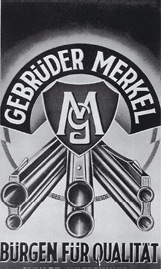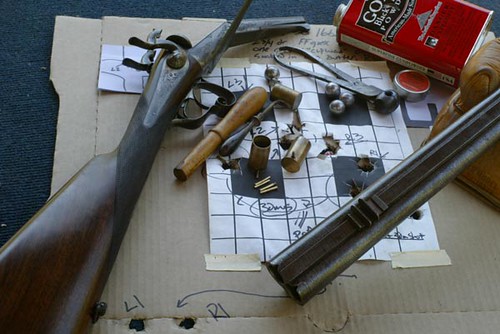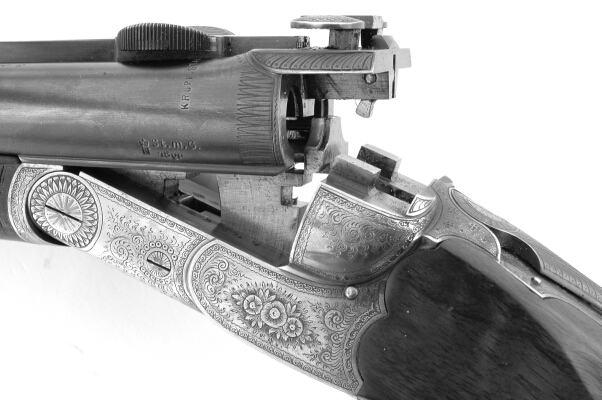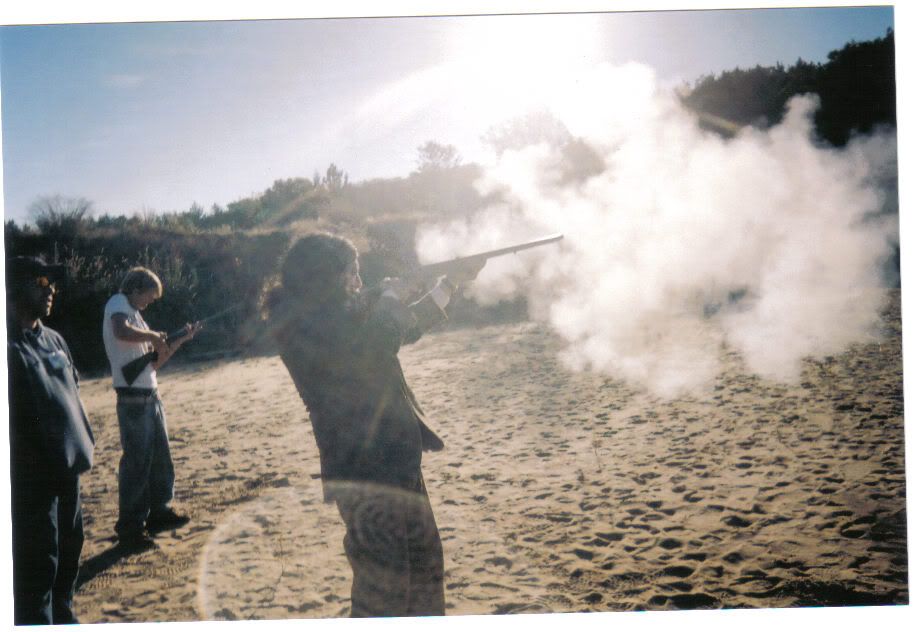| DRarchive |
| (.224 member) |
| 02/12/09 12:56 PM |
|
|
|
|
This double rifle was photographed by our member, Raff. He asked for it to be posted here in the archive.
This is a most unusual German double rifle, perhaps unique. Even though it is a radical design, it is strangely beautiful. The caliber is 9.3x74R.









Having posted the photos I will now ask Raff to give a verbal explanation of this ingenious mechanism.
| 450_366 |
| (.400 member) |
| 02/12/09 06:44 PM |
|
|
|
|
A rolling/drop block, one has to admire the german gunsmiths sometime.
Very neat gun for sure.
| Der_Jaeger |
| (.375 member) |
| 02/12/09 10:40 PM |

|
|
|
What an engineering and conceptual masterpiece. And I thought the French were the most innovative of gunmakers. It does seem a bit asynchronous to see a leupold scope mounted on a such a rifle. A classic Zeiss Diatal, possibly.
| Huvius |
| (.416 member) |
| 03/12/09 06:51 AM |

|
|
|
What is the maker?
Cant make out the inscription in the last photo.
| Raff |
| (.300 member) |
| 03/12/09 02:26 PM |
|
|
I happened to see this at a local shop in the for sale rack.
The shop owner was nice enough to let me shoot some photos
with my cheap camera. So please excuse the photo quality.
This rifle is a combination rolling and falling block. I
have never seen another even remotely like it.
When you lower the underlever, the breech block drops
streight down about 1 cm and two locking lugs retract from
the barrel extensions. Then as you move the lever further
to the front,the breech block rotates away from the barrels
to expose the chambers and allow the extractors to operate.
It would be a very difficult action to make and get the
timing correct on all the pieces and parts moving at once.
The barrels do not tilt, but are removable when you take
the forend off.
I didn't get a very good photo of the proof marks. German
Nitro with "108/49" stamped next to the marks.
Specifications;
Cal: 9.3x74R (no indication of bullet weight)
Weight: 9 lb. 6 oz. with scope
Greener style side safety.
Barrels: 25 1/2" (65 cm)
Sights: 1 standing, 1 folding with a bead front on a full
length rib. Claw scope mounts. 1" rings. Leupold 1-4 VXII.
Stock: 14 1/4" LOP over a 1/2" leather pad. Steel grip cap.
Front trigger is single set.
Maker: G. Kersten, Strassburg, Germany
If anyone would like further info. on this, let me know and
I'll check on it before this disappears from the store.
No, it is not mine and I have no interest in it other than
a love for doubles.
And many thanks to Capt. Curl for taking the time to post
the photos
Good Hunting
Raff
| tinker |
| (.416 member) |
| 03/12/09 03:50 PM |

|
|
|
Raff-
Is that the same 'hole in the world' my Tolley came out of?
Neat rifle!
Cheers
Tinker
| xausa |
| (.400 member) |
| 03/12/09 05:31 PM |
|
|
What's the number on the price tag?
| ellenbr |
| (.300 member) |
| 04/12/09 12:23 AM |
|
|
The load data is on the side and is probably a variant of "3,5 g GBP/STmG" or something of the like. The "108/49"(pre-1910 stamp) is the pre-rifling bore diameter of 0.350" which is very common for 9.3mm. Gustav Kersten was a prolific designer and if I recall correctly the brother-in-law of Franz Jaeger. Mr. Dietrich Apel is the grandson of Franz Jaeger and either would be interested in the pics or could provide additional info. There's another variant on the GGCA(German Gun Collector's Association) here: http://www.germanguns.com/questions.html .

I would look for a D.R.P. or D.R.G.M. stamp on the example. Gustav Kersten invented the Strassburger Verschluss which I think was under D.R.P. 141334. He's the father of the "Kersten Lockup", which was designed for SxSs but that is common on combo and O/U German guns. Somewhere I have additonal info on Kersten but zero on this example.
Kind Regards,
Raimey
rse
| SharpsNitro |
| (.375 member) |
| 04/12/09 02:51 PM |
|
|
Very neat old rifle. I'm fascinated by falling block doubles. How do the barrels attach?
| Raff |
| (.300 member) |
| 04/12/09 05:53 PM |
|
|
The action has a large pin through at the front, much like
a double rifle with tilting barrels. The barrels have a
notch that hooks around the pin and they are locked in
place when the forend is latched. They do not tilt to
remove, they just slide back and up when unlatched. A
very difficult arrangement to build.
Herr Kersten was a world class gunmaker from the looks of
this example.
Raff
| 88MauSporter |
| (.375 member) |
| 04/12/09 06:14 PM |
|
|
There is something unique about these German rifles. they have such a character and functional excentrics.
Question for Ellenbr. If the 108/49 relates to .350 for an unrifled bore how do I determine mine? I have a similar 108/49 stamping on my 9.5x56R combo German SXS. It is definatly a pre-1910. How do I translate the combination of numbers? The slugged bore measures about .374 in the grooves.
| 450_366 |
| (.400 member) |
| 04/12/09 07:31 PM |
|
|
|
|
Anyone got pictures of one of those germans with a couple of boltheads on the breech?
That must be a beast to fit proparly.
| Der_Jaeger |
| (.375 member) |
| 04/12/09 10:31 PM |

|
|
|
The Germans are the Worlds elite masters of complexities. Automobiles, guns, rifles, watches, clocks, optics.
Amazing, I never thought that was possible after watching the movie Braveheart

| ellenbr |
| (.300 member) |
| 05/12/09 12:16 AM |
|
|
Quote:
If the 108/49 relates to .350 for an unrifled bore how do I determine mine? I have a similar 108/49 stamping on my 9.5x56R combo German SXS. It is definatly a pre-1910. How do I translate the combination of numbers? The slugged bore measures about .374 in the grooves.
There's really not a translation. Imagine a broom handle, or something of the like, with a plug of 0.360" on one end and a plug of 0.350". Considering the stamp 108.49/108.49, it takes 108.49 spheres of lead with the diameter 0.350" to make a pound. A continuation of the 12 bore equals 12 balls but the fractional part is odd. Where are you going to get the fractional sphere?? When your unrifled tube passed by, 0.350" would pass the full length and 0.360" wouldn't pass the full length; thus the stamp. There are some tubes with seemingly odd stamps, but 0.37? sounds like either the fella pushing the plug the day of the proofing went the path of least resistance or there was some slight alteration during the making. On a smooth bore, 0.2mm/0.008" additional removal in polishing, or whatever, would require reproof. In an attempt to gather more knowns in solving a series of equations, a wax cast would be the next step. Just put a plug of paper/cotton/patch/whatever about 1" into the rifling and indefinitely borrow one of your wife's candels, using it to fill the chamber. Let it cool and punch it out. Measurements of the base, rim, etc. will help narrow the possibilities. I'd like to see your marks so could you post or email a pic of the flats and the area ahead of the flat?
Kind Regards,
Raimey
rse
| vikram |
| (.300 member) |
| 05/12/09 03:40 AM |
|
|
I have never seen a rifle like that.I have particular interest in German and Austrian gun makers.Very interesting and thanks for sharing.
Best-
Vikram
| Metalguy |
| (.300 member) |
| 05/12/09 02:46 PM |
|
|
Just when you think you've seen it all..... SHAZAAAAM!!!
| mehulkamdar |
| (.416 member) |
| 06/12/09 11:29 AM |

|
|
|
Raff,
Very, very interesting rifle. Thanks for sharing.
Raimey,
Did Kersten work for Merkel when he designed their O/U guns, or was his business bought out by Gebruder Merkel? Please do post on the history that you are aware of.
Thanks and good hunting!
| ellenbr |
| (.300 member) |
| 07/12/09 04:24 AM |
|
|
Gustav Kersten didn’t play 2nd fiddle to anyone and I would say one might tread on sacrilege saying Gustav Kersten worked for Merkel. Merkel designed their O/Us based on his patented lockup. I don't know if Merkel paid him a royalty or if they had some agreement. But Gustav Kersten was at the very least a very talented inventor and was sourced by many including R. Bessel & Sohn of Bulgaria for his Karpaten Vershcluss, which was the pic I posted earlier and can be found under DRP Nr. 201507. And I’ve seen another example, less the engraving, that has a D.R.G.M. number of 201501 and has a stamp of “G. Kersten, Mod IV” noting he offered several models.
Gustav Kersten stems from a long line of Swedish blacksmiths, one of which was severely wounded in battle in Germany and couldn’t return to his homeland of Sweden. Gustav Kersten joined the Prussian army and elevated himself to the rank of a Master Armourer. While stationed in Strassburg and in the aftermath of WWI, Gustav Kersten decided to reside in Strassburg; hence, the name Strassburg Verschluss. Gustav Kersten had some close connection to Zella Saint Blasii/Mehlis as he arranged an opportunity for Franz Jäger to be an apprentice in the Zella-Mehlis area. Gustav Kersten may have sourced the craftsmen of Zella Saint Blasii for his examples or he may have switched to the Jaeger folks(which had 50 craftsmen pre-WWI) considering the family relationship, which was how components were sourced in Suhl. Franz Jäger wasn’t the oldest of the Jäger children on the farm and had to leave the farm and pursue an alternative occupation to farming. And it was one his sister’s that married Gustav Kersten. Franz Jäger, like Gustav Kersten, had several lockup patents being #209113 of 1906 for the Jäger Vertikal-Blockverschluss and No. 176578, both of which was in combination with the Simson company. Merkel & Blaser have utilized patent No. 209113. Simson was definitely involved with Jäger but I can’t say that Merkel was. But then again the Suhl – Zella-Mehlis was chocked full of craftsmen and everyone knew everyone. One note though is that the craftsmen in Suhl considered the Zella-Mehlis craftsmen to be a rung lower.
From my limited knowledge of Gebrüder Merkel or Merkel Brothers, who were Albert Oskar, Karl Paul and Gerhard/Gebhardt? Merkel, is that in 1898 founded their firm with a huge emphasis on O/U predating the British emphasis by Lancaster(boxlock) Woodward, Beesley(Shotover) & Purdey(Sextuple grip) and I do realize that the latter were of sidelock configuration. Albert Oskar and Gerhard/Gebhardt didn't ghee-haw and Albert Oskar left in 1907 to hang out his own shingle in 1908 and I think MERCO to be their stamp. In 1916 Gebrüder Merkel experienced restructuring as exited as Suhler Waffenwerk Gebrüder Merkel. Times were very tough Post WWI and many, many firms fell by the wayside or were absorbed by stronger firms. Heinrich Barella(January 3rd, 1819 in Soest to 1893 in Berlin), who was the uncle of Heinrich Leue, wasn’t any different and was purchased by the Lignose firm and the Lignose firm was absorbed by Merkel with one date given as early as 1927. There was a strong relationship between the Heinrich Barella firm and Merkel as Barella sourced Merkel for their examples and Bernhard Merkel looks to be the source for the clamshell frames as well as the unique boxlock frames seen on Foerster, Reeb, Schiwy, etc. Merkel may have had a frame forge, but for now I don’t think so and I guess them to have sourced Sauer for their frames. Many, many makers sourced Merkel for their frames. Merkel also purchased an interest at the very least in Gottfried Funk in 1925. Gebhardt Merkel expired in 1933 with Ernst Merkel taking the reins. Merkel received its share of ups and downs and by 1939 Adolf Schade was the owner.
And not to forget another of the Merkel klan, Ernst August Merkel was the son of master engraver Ernst Ferdinand Merkel. Ernst August Merkel had a pre-1900 founding and had one of his sons, Rudolf Otto Merkel, as a principal. Ernst August’s brother’s Otto Gottlieb and Louis Franz Ferdinand worked under the E.A. Merkel umbrella.
I failed to mention that there were other unique doubles with interesting lockups such as those by Karl Friedrich Phillip Stendebach who advertised as Fr. Stendebach, Waffen und Geschossfabrik in Suhl. He had a November 14th 1905 patent for an O/U double rifle under patent 804349, http://www.google.com/patents?id=xnBkAAA...;q=&f=false , and a SxS in 1910.
Kind Regards,
Raimey
rse